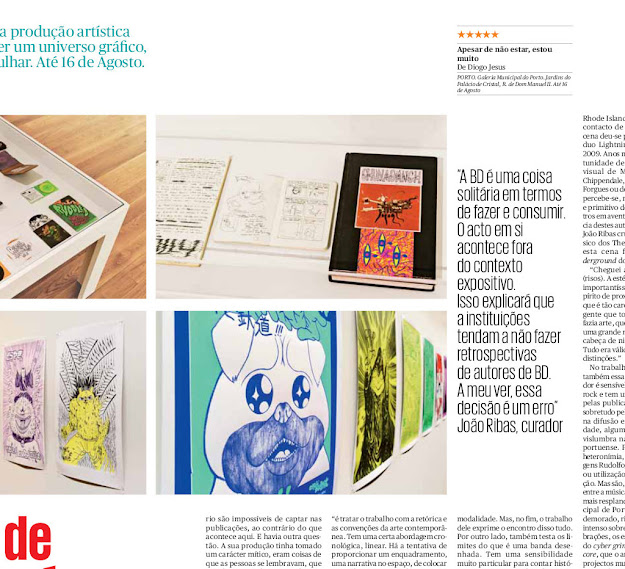Deserto e Nuvem
por
+
1 claustro vazio em Évora
1 ordem católica de silêncio e solidão
1 inquérito espiritual
2 livros num só
20 cartas sem resposta
Muitas visitas do autor em dúvida
+
Sexto volume da colecção LowCCCost editado por Marcos Farrajota com arranjo gráfico de Joana Pires e publicado pela Chili Com Carne.
Dois livros / split-book, 64p impressas a 1 cor + 124p impressas a 2 cores, 16,5x23cm
+
ESGOTADO
talvez ainda encontre exemplares na Linha de Sombra, ZDB, BdMania, Tasca Mastai, Utopia, Stet, Mundo Fantasma,
LAR / LAC (Lagos),
Matéria Prima, Sirigaita, You to You,
XYZ,
A Vida Portuguesa UND Modern Graphics (Berlin)
+
Deserto e Nuvem são obras de longo curso que examinam a forma de vida na Cartuxa de Évora, onde alguns monges resistem aos costumes do mundo, em absoluto silêncio e solidão. Serve este exame de pretexto para focar a própria natureza da fé humana, do apego às coisas do mundo, do que nos faz sentido.
Deserto é composto de uma única narrativa centrada numa semana passada junto a Scala Coeli (escada do céu), que é como se chama a Cartuxa de Évora. É um livro quase jornalístico.
Nuvem é composto de 20 cartas endereçadas a um monge cartuxo, e pode ser lido como uma resistência contra ambos os extremos que circundam a fé – o extremo que sabe que Deus não existe, e o extremo que se contenta com absurdos.
+
sobre o autor: Chamo-me Francisco Sousa Lobo, tenho 43 anos e vivo no Reino Unido, entre Londres e Falmouth, onde ensino ilustração e faço banda desenhada. Já estive do lado dos católicos e dos que renegam as raízes católicas. Agora ando sossegado, sentado numa espécie de muro baixinho, a ler Simone Weil e Kierkegaard. A perspectiva que tenho de cima do muro é curiosa. Tão curiosa que me deu para escrever sem ver que três ou quatro anos se passaram nisto.
...
Acabei agora de ler o Deserto e a Nuvem.
O meu obrigado sincero à Chili por tê-lo editado.
M. Robin (via e-mail, 11/07/17)
Comics making as a form of prayer?
Pedro Moura / Yellow Fast & Crumble
No caminho que levou a Deserto/ Nuvem, que se pressente longo e hesitante (a vários níveis), Sousa Lobo tenta construir pontes frágeis entre estes vários aspectos, como o harmónio de cartão que une os livros. E, sobretudo, procura acreditar nelas. Para além do fascínio com a vida e opções dos cartuxos, e os paralelos que o autor estabelece com a sua arte, este é sobretudo um catálogo de dúvidas sem resposta. Como se duas obras semi-falhadas ou incompletas se resgatassem e engrandecessem mutuamente pela união enquanto gémeas siamesas invertidas; o onirismo poético de uma elevando-se na realidade de um Alentejo moribundo e sem rumo da outra; a qual, por sua vez, ancora a anterior. Na sua construção inclassificável este é um excepcional trabalho de Francisco Sousa Lobo, com elogios extensíveis à Chili Com Carne. Seria uma pena se (como os trabalhos de autores como António Jorge Gonçalves, Tiago Manuel ou Diniz Conefrey) não passasse bem para lá do universo da banda desenhada e dos seus rituais.
João Ramalho Santos in Jornal de Letras
(...) Livro que "pode ser lido como uma resistência contra ambos os extremos que circundam a fé", por um lado o "que sabe que Deus não existe" e o "extremo que se contenta com absurdos".
Nuno Galopim in Expresso
el portugués confirma ser uno de los autores más sugerentes del panorama europeo actual. Una obra formada por dos relatos: por un lado, el que realiza sobre la Cartuja de Évora, una magistral reflexión sobre la existencia, sobre el silencio y la creencia, en la que Sousa entremezcla la arquitectura de la página con la real. Por otro, el relato del proceso creativo, de la investigación y de sus reflexiones personales, de cómo la obra puede cambiar al autor.
Álvaro Pons / La Cárcel de Papel
(...) a mais fascinante experiência de leitura de banda desenhada deste ano.
There is no doubt that Lobo’s obsessive and proficient output is even more surprising for both its aesthetic and philosophical commitment. I’ve argued elsewhere that Lobo’s overall project touches an incredibly original and complicated autobiographical or auto-fictional project, but this double book (two titles, Desert and Cloud, bound back-to-back) ticks all the boxes of a straightforward autobiography. Lobo spent some time visiting Évora’s Carthusian Monastery of Santa Maria Scala Coeli, with the goal of creating a sort of ‘live’ comic project. Based on his observations, talks and theological discussions with the monks, Deserto explores issues such as isolation, silence and the relationship with God, which genuinely concern Lobo as an anxious, suffering Catholic artist (a pleonasm, I’m certain). Nuvem, on the other hand, takes the shape of short letters, addressing the history of the order and this monastery, as well as some of the concerns mentioned above. One half complements the other, reinforcing the themes and clearly making them an intrinsic ingredient to the artist’s recurrent obsessions.
Deserto/ Nuvem es realmente una maravilla de Sousa Lobo -¡qué difícil, un cómic sobre la espiritualidad!- y también una maravilla de edición. Os felicito!
Max (Peter Pank, Bardin, Vapor) por email
Todos os anos vou como um peregrino ao Festival de BD da Amadora (que este ano foi entre 26 de Outubro e 11 de Novembro) para completar colecções, comprar novidades ou descobrir antiguidades, mas desta vez saí de lá mais surpreendido do que o costume com um livro: não levei só heróis habituais como o Corto Maltese, o Árabe do Futuro ou um Paul Auster no saco das compras, mas também monges de clausura visitados por um autor português com raízes no Alentejo que vive em Londres e tem dúvidas existenciais sobre Deus e a religião: Deserto/ Nuvem (editora Chili com Carne) é uma novela gráfica original. Primeiro, porque é dois livros num só, que começam em cada uma da capas, ou melhor, em cada uma das contracapas: Deserto é sobre as visitas do autor, Francisco Sousa Lobo, ao Convento da Cartuxa, e a relação com os poucos e velhos monges com votos de silêncio que ainda lá vivem; Nuvem dá forma a 20 cartas de carácter sobretudo filosófico enviadas a um monge cartuxo; a ligá-los, uma planta desdobrável do convento dá ao livro uma textura de velho incunábulo, de lombada cosida à mão. É um belo objecto.
Mas não só. Sousa Lobo leva-nos em visita aos claustros, aos hábitos dos monges, à rotina e à perplexidade: seja-se religioso ou não, aquelas vidas suprimidas pelo silêncio naqueles espaços deixam-nos incrédulos. Abdicam do humano em favor do etéreo?, questiona o desenhador (e arquitecto) numa das cartas. O próprio autor está em cima do muro entre os crentes e os não crentes, mas tenta compreender o ponto de vista dos enclausurados e exprime um assombro perante aquela resiliência e desistência da vida comum: Há uma nuvem entre mim e os monges, uma admiração profunda deste lado, escreve. Francisco Sousa Lobo ganhou o prémio para o Melhor Álbum Português de BD em 2018. Percebe-se porquê. É merecido.
O trabalho de Francisco Sousa Lobo espelha uma experiência vivencial intensa no plano intelectual e artístico, a de alguém com uma forte capacidade para gerar nexos entre assuntos só aparentemente distantes – uma lonjura que o seu traço e dispositivo narrativo encurtam consideravelmente. Talvez por isso o autor se refira a si próprio como «uma ponte entre a banda desenhada e as outras artes» (Nuvem, carta 18.ª). E talvez o facto de ser um arquitecto tenha qualquer coisa a ver com tudo isto.
Trata-se de um ilustrador de pensamentos, capaz de desenhar sobre conceitos abstractos, como em Deserto, livro que percorre o fio do tempo e dos gestos que, em 2014 (época já de grande crise de vocações), levaram Sousa Lobo à Cartuxa de Évora para pensar (escrever, desenhar) sobre os lendários monges do lugar. Ou seja, sobre o que levou o autor a querer pensar (escrever, desenhar) sobre a condição do homem que fez voto de silêncio, sobre o que o silêncio faz, sobre como se faz para alcançá-lo, porquê, para quê, tudo isso no desamparo desabafado de quem afirma ter-se sentido «como um clandestino a trepar as escadas para o céu». (...)
(...) um bom domingo antecipa a segunda e pode dar para chorar. Assim como a vida de um monge. Fala de um lugar onde pousar a dor.














































